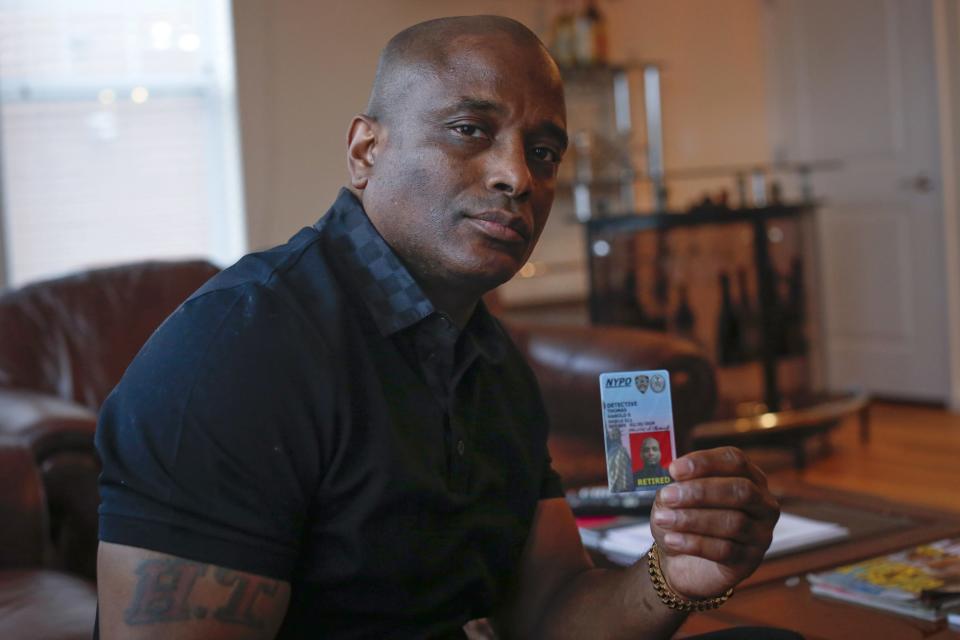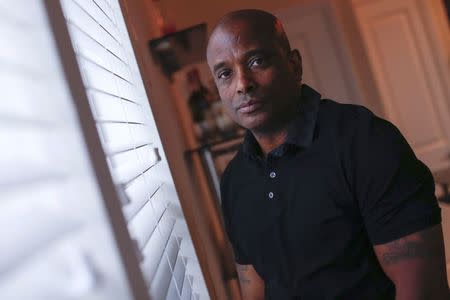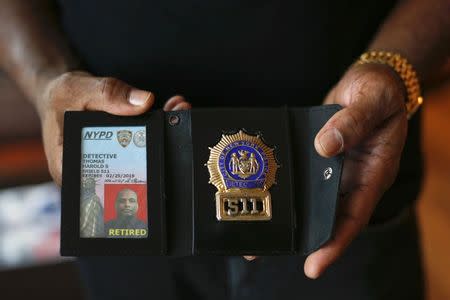Off duty, black cops in New York feel threat from fellow police
By Michelle Conlin NEW YORK (Reuters) - From the dingy donut shops of Manhattan to the cloistered police watering holes in Brooklyn, a number of black NYPD officers say they have experienced the same racial profiling that cost Eric Garner his life. Garner, a 43-year-old black man suspected of illegally peddling loose cigarettes, died in July after a white officer put him in a chokehold. His death, and that of an unarmed black teenager in Ferguson, Missouri, has sparked a slew of nationwide protests against police tactics. On Saturday, those tensions escalated after a black gunman, who wrote of avenging the black deaths on social media, shot dead two New York policemen. The protests and the ambush of the uniformed officers pose a major challenge for New York Mayor Bill De Blasio. The mayor must try to ease damaged relations with a police force that feels he hasn’t fully supported them, while at the same time bridging a chasm with communities who say the police unfairly target them. What’s emerging now is that, within the thin blue line of the NYPD, there is another divide - between black and white officers. Reuters interviewed 25 African American male officers on the NYPD, 15 of whom are retired and 10 of whom are still serving. All but one said that, when off duty and out of uniform, they had been victims of racial profiling, which refers to using race or ethnicity as grounds for suspecting someone of having committed a crime. The officers said this included being pulled over for no reason, having their heads slammed against their cars, getting guns brandished in their faces, being thrown into prison vans and experiencing stop and frisks while shopping. The majority of the officers said they had been pulled over multiple times while driving. Five had had guns pulled on them. Desmond Blaize, who retired two years ago as a sergeant in the 41st Precinct in the Bronx, said he once got stopped while taking a jog through Brooklyn’s upmarket Prospect Park. "I had my ID on me so it didn’t escalate," said Blaize, who has sued the department alleging he was racially harassed on the job. "But what’s suspicious about a jogger? In jogging clothes?" The NYPD and the Patrolmen's Benevolent Association, the police officers’ union, declined requests for comment. However, defenders of the NYPD credit its policing methods with transforming New York from the former murder capital of the world into the safest big city in the United States. EX-POLICE CHIEF SKEPTICAL "It makes good headlines to say this is occurring, but I don’t think you can validate it until you look into the circumstances they were stopped in," said Bernard Parks, the former chief of the Los Angeles Police Department, who is African American. "Now if you want to get into the essence of why certain groups are stopped more than others, then you only need to go to the crime reports and see which ethnic groups are listed more as suspects. That’s the crime data the officers are living with." Blacks made up 73 percent of the shooting perpetrators in New York in 2011 and were 23 percent of the population. A number of academics believe those statistics are potentially skewed because police over-focus on black communities, while ignoring crime in other areas. They also note that being stopped as a suspect does not automatically equate to criminality. Nearly 90 percent of blacks stopped by the NYPD, for example, are found not to be engaged in any crime. The black officers interviewed said they had been racially profiled by white officers exclusively, and about one third said they made some form of complaint to a supervisor. All but one said their supervisors either dismissed the complaints or retaliated against them by denying them overtime, choice assignments, or promotions. The remaining officers who made no complaints said they refrained from doing so either because they feared retribution or because they saw racial profiling as part of the system. In declining to comment to Reuters, the NYPD did not respond to a specific request for data showing the racial breakdown of officers who made complaints and how such cases were handled. White officers were not the only ones accused of wrongdoing. Civilian complaints against police officers are in direct proportion to their demographic makeup on the force, according to the NYPD’s Civilian Complaint Review Board. Indeed, some of the officers Reuters interviewed acknowledged that they themselves had been defendants in lawsuits, with allegations ranging from making a false arrest to use of excessive force. Such claims against police are not uncommon in New York, say veterans. STUDIES FIND INHERENT BIAS Still, social psychologists from Stanford and Yale universities and John Jay College of Criminal Justice have conducted research – including the 2004 study "Seeing Black: Race, Crime and Visual Processing" - showing there is an implicit racial bias in the American psyche that correlates black maleness with crime. John Jay professor Delores Jones-Brown cited a 2010 New York State Task Force report on police-on-police shootings - the first such inquiry of its kind - that found that in the previous 15 years, officers of color had suffered the highest fatalities in encounters with police officers who mistook them for criminals. There’s evidence that aggressive policing in the NYPD is intensifying, according to data from the New York City Comptroller. Police misconduct claims - including lawsuits against police for using the kind of excessive force that killed Garner - have risen 214 percent since 2000, while the amount the city paid out has risen 75 percent in the same period, to $64.4 million in fiscal year 2012, the last year for which data is available. REPORTING ABUSE People who have taken part in the marches against Garner's death - and that of Ferguson teenager Michael Brown - say they are protesting against the indignity of being stopped by police for little or no reason as much as for the deaths themselves. “There’s no real outlet to report the abuse,” said Brooklyn Borough President Eric Adams, a former NYPD captain who said he was stigmatized and retaliated against throughout his 22-year career for speaking out against racial profiling and police brutality. Officers make complaints to the NYPD’s investigative arm, the Internal Affairs Bureau, only to later have their identities leaked, said Adams. One of the better-known cases of alleged racial profiling of a black policeman concerns Harold Thomas, a decorated detective who retired this year after 30 years of service, including in New York's elite Joint Terrorism Task Force. Shortly before 1 a.m. one night in August 2012, Thomas was leaving a birthday party at a trendy New York nightclub. Wearing flashy jewelry, green sweatpants and a white t-shirt, Thomas walked toward his brand-new white Escalade when two white police officers approached him. What happened next is in dispute, but an altercation ensued, culminating in Thomas getting his head smashed against the hood of his car and then spun to the ground and put in handcuffs. “If I was white, it wouldn’t have happened,” said Thomas, who has filed a lawsuit against the city over the incident. The New York City Corporation Counsel said it could not comment on pending litigation. At an ale house in Williamsburg, Brooklyn last week, a group of black police officers from across the city gathered for the beer and chicken wing special. They discussed how the officers involved in the Garner incident could have tried harder to talk down an upset Garner, or sprayed mace in his face, or forced him to the ground without using a chokehold. They all agreed his death was avoidable. Said one officer from the 106th Precinct in Queens, “That could have been any one of us.” (Editing by Ross Colvin)






